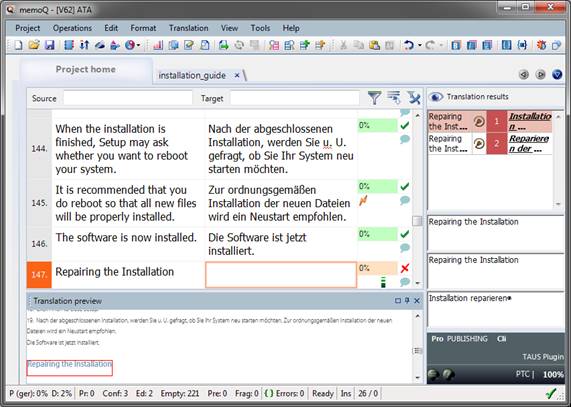|
Front Page
|
| |
|
|
Friendly Files and Fancy Formatsby Jost Zetzsche | |
|
Well, I now believe this has changed, and I just wonder whether this could foreshadow larger changes in our world. But let's first talk about why translators even have to worry about desktop publishing formats. The truth is, of course, that we don't have to. There are plenty of jobs out there in easier-to-deal-with formats, and the vast majority simply don't know enough about tools like InDesign or Quark to start with.
Programs like InDesign were simply too expensive for that every-once-in-a-while job. And the problem was that once you shelled out the $700 to purchase the program, the next upgrade costing $300 was just around the corner, and that would be the version that your next client would need for his files. So we were caught in a never-ending spiral of payments for something that really did not seem to pay out. The result: most of us happily declined. This whole scenario is not only true for InDesign but for many other products as well, including Photoshop, Illustrator, and even Flash. You might have noticed that all the programs above are Adobe programs. This has two reasons: First of all, each Adobe product is the leader in its respective field (InDesign in design-based desktop publishing, Photoshop for pixel-based graphics, Illustrator for vector-based graphics, and Flash for, well, Flash). More importantly in our context, though, they're now all available by subscription through Adobe—either collectively as a package with the CreativeCloud offering for $50 a month or individually for $20 a month. I regret that it wasn't I who persuaded Shantanu Narayen, the CEO of Adobe, to introduce this for the sake of the many thousands of translators who might benefit from it. In fact, I'm afraid that translators didn't even cross the minds of the powers-that-be at Adobe when they launched this last May. But it sure is perfect for us. From now on out, this means that you can download (and pay for) the tool you need when you need it (despite its name, the offering is not a true "cloud" offer; you still have to download and install). You'll never have to worry about upgrades again because you will automatically have access to the latest versions, and there is no reason for you to refuse a job because of a format that is supported by these tools. Of course, here's what I wonder about: Doesn't this sound like a great time to introduce a new business concept? Clients expect us to own certain tools, and as professionals we should have access to these basics, including the typical office programs and probably a translation environment tool. Then there are the tools that are (now) accessible but that have a—very transparent—price tag (which would include the monthly fee and the time you'll spend for the download and the installation). What a perfect opportunity for us to say: "My fee consists of a service fee—based on the size and the complexity of the job—and a software usage fee—based on whether this software should be expected to be in a translator's tool box." This would have been hard to justify with the typical licensing scheme that was used in the past, but now this fee structure should be a no-brainer, even though the software has ironically become more affordable. And what about actually using the software? Wouldn't that require training as well? It sure would—if you intended to become a professional layouter or graphic artist. But for what we need to do in InDesign, Photoshop, or Illustrator, the level of expertise is typically so minute that it should be a breeze to find your way around the programs. In most cases, the actual translation typically takes place in a translation environment tool (virtually all of which support the InDesign export formats, for instance), and the work in the DTP application consists of merely making sure that the text fits the intended space. And while we're talking about InDesign files, Kilgray (maker of the translation environment tool memoQ) has started to offer a free online InDesign conversion service as part of its online storage and sharing site Language Terminal. Here you can upload your original InDesign INDD file (of any version) and have it converted to an XLIFF file which can be translated with any supporting tool (essentially every translation environment tool supports XLIFF). If you don't use memoQ, it admittedly takes a bit of finagling with the Language Terminal file before you can process it in another tool—but the MQXLZ file you receive is actually just a zipped file, so you can simply extract the XLIFF file. Ideally you will want to process it in memoQ, though, since here you can see a very cool live preview of your translation in the original InDesign layout as you translate so that later fixes to overflowing text can already be reduced.
Image 1: memoQ translating and previewing an InDesign file that was prepared in Language Terminal
At the beginning of this year—2012—I wondered in my ATA Chronicle column whether this year might become the year of the translator. I think in many ways it has. Nataly Kelly's and my Found in Translation: How Language Shapes Our Lives and Transforms the World was the first book produced by a major publisher about translators and interpreters from the viewpoint of professionals. Our video—featuring you—has been viewed thousands of times. Translation technology has made some fundamental—and challenging—jumps forward. And fresh licensing models like the one described above are opening new doors for us to offer innovative services and charge for them differently. It's been a good year. Have a blessed 2013. |
|
|
|
